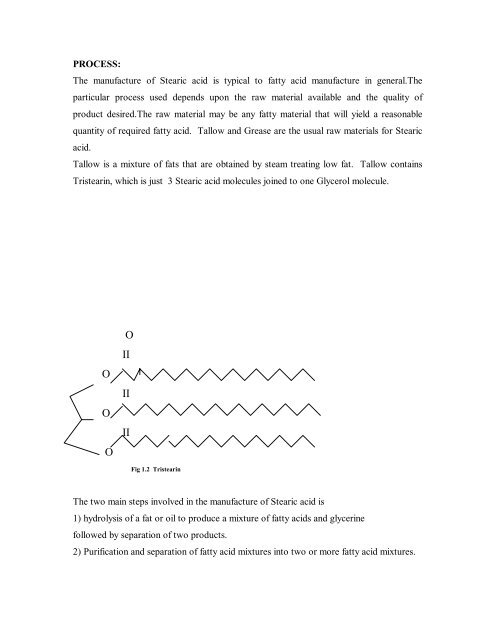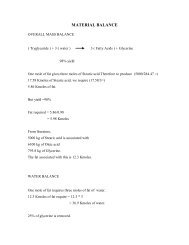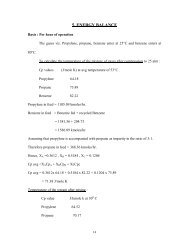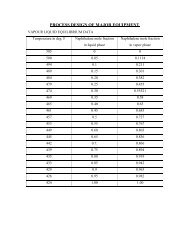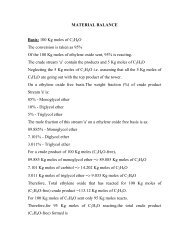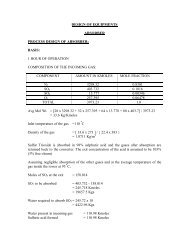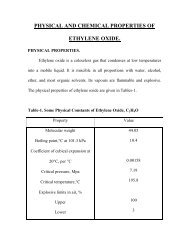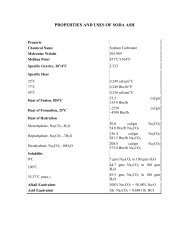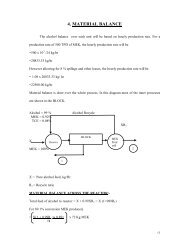Stearic Acid Methods Of Production
Stearic Acid Methods Of Production
Stearic Acid Methods Of Production
- No tags were found...
You also want an ePaper? Increase the reach of your titles
YUMPU automatically turns print PDFs into web optimized ePapers that Google loves.
PROCESS:The manufacture of <strong>Stearic</strong> acid is typical to fatty acid manufacture in general.Theparticular process used depends upon the raw material available and the quality ofproduct desired.The raw material may be any fatty material that will yield a reasonablequantity of required fatty acid. Tallow and Grease are the usual raw materials for <strong>Stearic</strong>acid.Tallow is a mixture of fats that are obtained by steam treating low fat. Tallow containsTristearin, which is just 3 <strong>Stearic</strong> acid molecules joined to one Glycerol molecule.OOOOIIIIIIFig 1.2 TristearinThe two main steps involved in the manufacture of <strong>Stearic</strong> acid is1) hydrolysis of a fat or oil to produce a mixture of fatty acids and glycerinefollowed by separation of two products.2) Purification and separation of fatty acid mixtures into two or more fatty acid mixtures.
The two principal grades of commercially produced stearic acid are called:♦ Commercial/Pressed acid and♦ Distilled / Solvent – crystallized acidproduced by1. TWITCHELL PROCESS AND PRESSING2. CONTINUOUS HIGH – PRESSURE SPLITTING AND SOLVENTCRYSTALLIZATIONrespectively.TWITCHELL PROCESS:The manufacture of <strong>Stearic</strong> acid, the most important of the fatty acids of commerce, istypical of fatty acid manufacture in general. The particular process used depends uponthe raw material available and the quality of product desired. In any case, manufactureinvolves two separate operations: (1) hydrolysis of a fat or oil to produce a mixture offatty acids and glycerine, followed by separation of the two products and(2) purification and separation of the fatty acid mixtures into two or more fatty acidproducts.The process shown in the flowsheet shows widely used, if not the most modern,processes of fat – splitting (hydrolysis) and subsequent purification and separation of theresulting fatty acids.The raw material may be any fatty material that will yield areasonable quantity of the required fatty acid. Tallow and Grease are the usual rawmaterials for <strong>Stearic</strong> acid. Either raw material is first washed with strong sulfuric acid toremove albuminous material and other catalyst poisons. The fat is then mixed with 25 to50 per cent water (by weight), about one per cent Twitchell reagent (an aromatic sulfonicacid that acts as a catalyst), and 0.5 per cent sulfuric acid. It is then hydrolyzed byboiling in open tanks with steam for 24 to 36 hr. Two to four stages are normally usedwith the glycerol – containing sweetwater being withdrawn and replaced with fresh waterat the end of each stage. The efficiency with which the fat is hydrolyzed to fatty acidsand glycerine is better than 90 per cent. The sweetwater (glycerine – water solution) is
purified and concentrated. The dark – colored fatty acids are then fed to a batch stillwhere by vacuum or steam distillation the acids are distilled overhead, and a tarry residueis removed as bottoms. A typical distillate from grease fatty acids contains 40 to 50 percent saturated acids (chiefly Palmitic and <strong>Stearic</strong> acids), up to 10 per cent Linoleic acid,and 40 to 45 per cent Oleic acid.To separate the solid, saturated acids from the unsaturates, the distillate produced asabove is pumped into pans which are chilled in a refrigerated rack. After cooling, thesolid cakes are removed, wrapped in burlap bags, and pressed in a hydraulic press.Theliquid pressed out is “red oil” (commercial Oleic acid): the residue is single – pressed<strong>Stearic</strong> acid (actually in common practice 55 percent Palmitic acid and 45 percent <strong>Stearic</strong>acid, with an iodine value of 9 to 14). If the solid cake is reformed and given a hot pressin the presence of steam, the product is double – pressed stearic acid. Recasting andrepressing at a higher temperature yields triple – pressed acid.TALLOW OR GREASEH 2 SO 4 ACIDH 2 0TWITCHELL REAGENTH 2 SO 4 ACID
Fig 1.3 From Fat By Twitchell Process And PressingHIGH PRESSURE SPLITTING AND SOLVENT CRYSTALLIZATIONA selected fat stock is first pumped through a deaerator to prevent darkening byoxidation during processing. It is then pumped at a temperature of 140 0 F into the bottomof a continuous reaction chamber or column where it flows counter currently to hot waterdescending the column.The molten fat feed enters the reactor through a sparger whichdisperses the fat stock to droplets so as to give better contact with the water. The liquid inthe middle of the column is heated to 500 0 F (725 psi) by the introduction of 800 psisteam at appropriate levels in the tower. Contact time is 3 to 5 hours. Efficiency ofsplitting is 97 to 99 per cent. The sweet water leaving the bottom of the column contains10 to 25 per cent glycerine and needs only a light lime treatment prior to concentration.The fatty acids leaving the top of the splitter may be purified and separated by eitherfractional distillation or crystallization. The method shown in the flowsheet, continuous– process fractional crystallization, is adapted to a wider range of fat stocks than thepressing process. In the latter process only solid animal fatty acids with the proper ratioof Palmitic acid to <strong>Stearic</strong> acid may be crystallized easily. In the continuous process nosuch limitation exists.The most common solvents are acetone, aqueous methanol, and liquid propane. In theprocess shown, a solution of fatty acids in aqueous methanol is pumped through a chillerin which the solution is cooled indirectly by a refrigerant.The saturated fatty acidscrystallize and are removed on a continuous vacuum filter. The cake goes to a stripping
still where solvent is removed and the <strong>Stearic</strong> acid recovered. The product is equivalentto double – pressed <strong>Stearic</strong> acid. In a like manner, Oleic acid is recovered from thefiltrate, at about 90 per cent purity.Fig 1.4 Continuos High Pressure Splitting And Solvent Crystallization
PROCESS CHOSEN:The process chosen is Fat by continuous high pressure splitting, and separationof <strong>Stearic</strong> acid and Oleic acid by crystallizatiaon using flooded chiller. Also, this processis widely used in commercial process known as Colgate – Emery process by HindustanLeverThe continuous process fractional crystallization is adapted to wider range of fat stocksthan pressing process.


